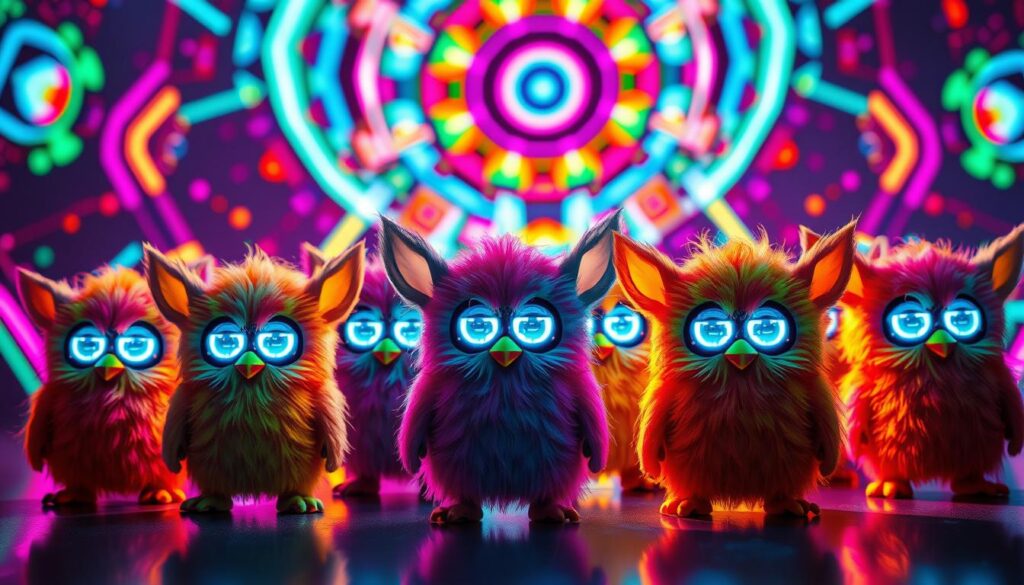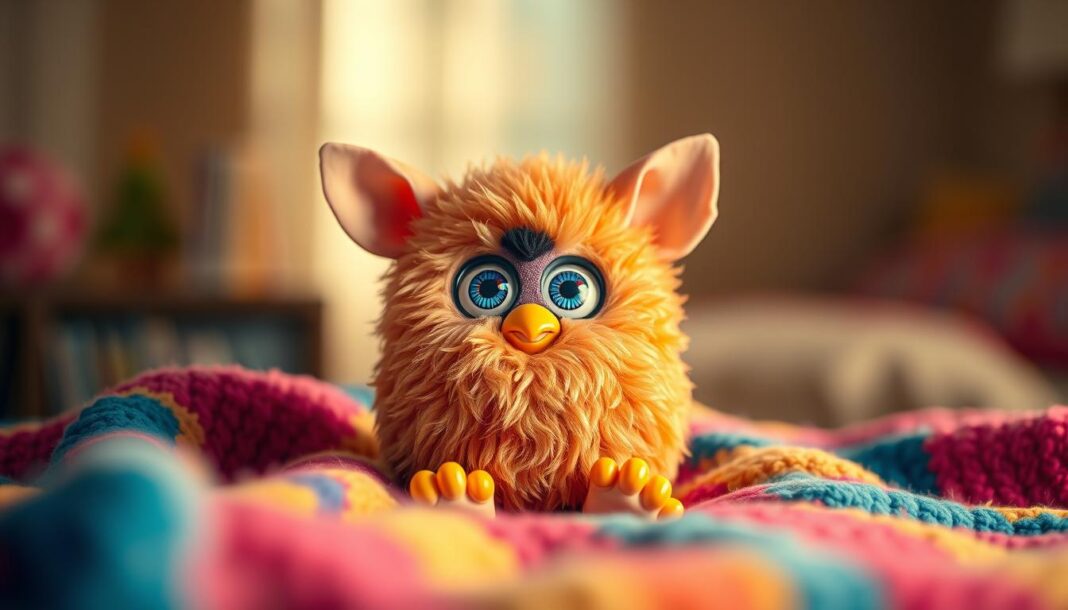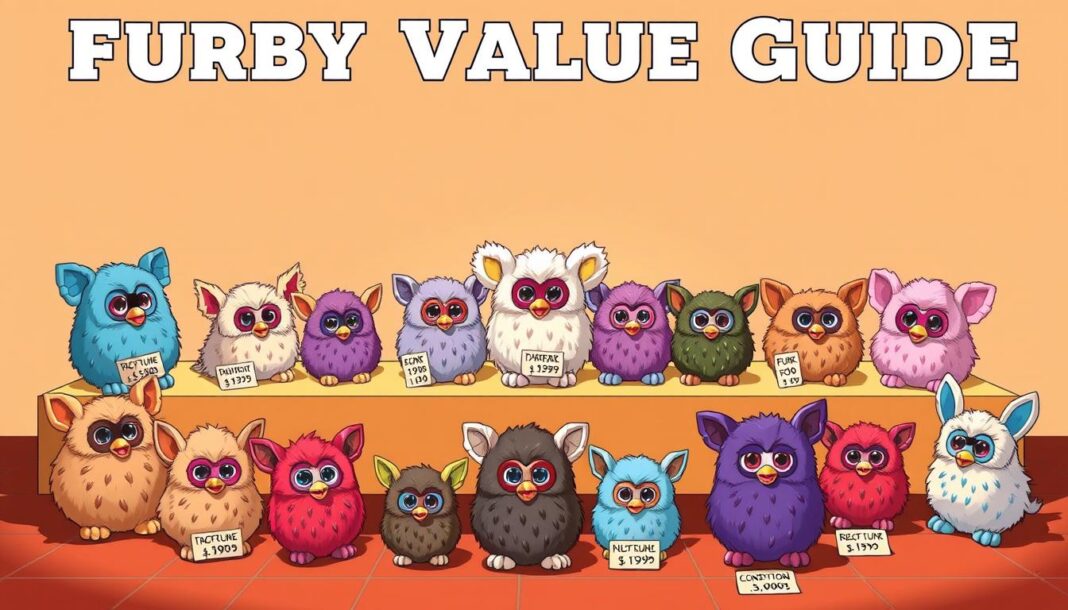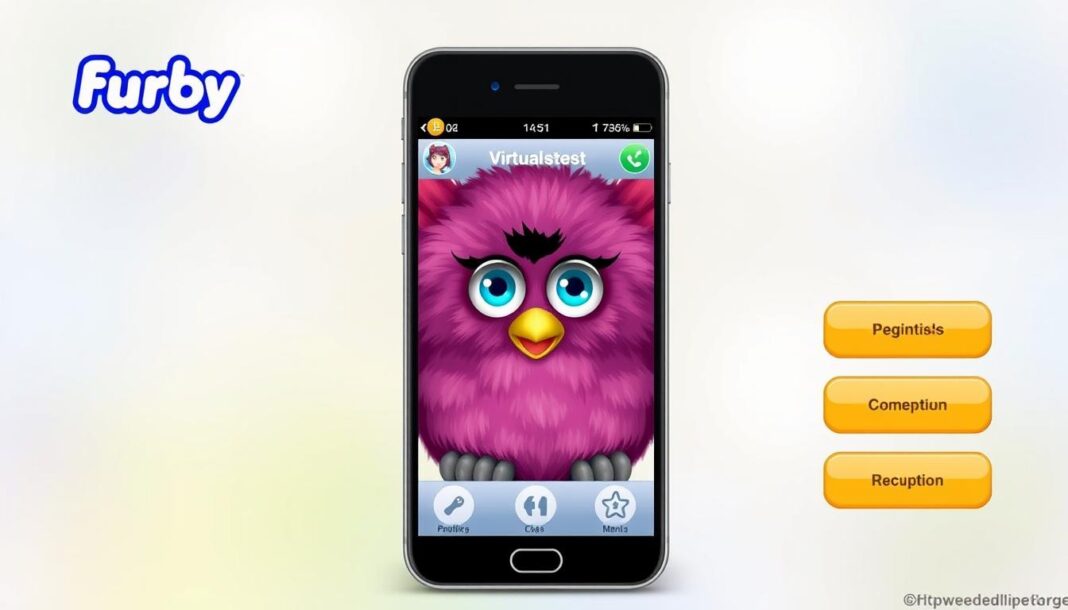In the late 1990s, a revolutionary electronic toy took the world by storm, captivating a generation of children and adults alike. The Furby, created by Tiger Electronics, was originally released in 1998 and quickly became a “must-have” item during the holiday season.
With its unique ability to seemingly learn and develop over time, the Furby created a personal connection with its owners. Over 40 million units were sold during its initial production run, with prices skyrocketing from the original $35 retail to hundreds of dollars in the secondary market.
We will explore how this innovative toy changed the landscape of interactive playthings and left a lasting cultural legacy that continues to resonate today.
The Birth and Rise of Furbies
Furbies owe their existence to the innovative minds of David Hampton and Caleb Chung, who spent 18 months designing and creating the toy. This section delves into the fascinating story behind the creation and rise of Furbies.
The Creation Story: Hampton and Chung’s Vision
David Hampton and Caleb Chung spent nine months designing and another nine months creating the Furby. Their efforts culminated in a revolutionary toy that could interact with its owner. After initial attempts to license the concept, they partnered with Richard C. Levy, who played a crucial role in presenting Furby to Tiger Electronics. Roger Shiffman of Tiger Electronics saw the potential and bought the rights to Furby. The Furby’s first public appearance was at the American International Toy Fair in 1998. The source code, written by David Hampton and Wayne Schulz, was designed to run on a variation of the 6502 microprocessor.
The 1998 Holiday Season Phenomenon
The 1998 holiday season marked a significant turning point for Furbies. As the toy hit the shelves, it became an instant hit, captivating children and adults alike. Furbies were not just toys; they were interactive pets that could learn and adapt, making them a must-have gift during the holiday season.
Record-Breaking Sales and Cultural Impact
Furbies broke sales records, with 1.8 million units sold in 1998 and a staggering 14 million in 1999. This phenomenal success was not just a testament to the toy’s appeal but also its cultural impact. Furbies became a cultural phenomenon, sparking shopping frenzies across America.
| Year | Units Sold (in millions) |
|---|---|
| 1998 | 1.8 |
| 1999 | 14 |
The story of Furbies is a testament to innovative design, perseverance, and the power of interactive technology. From its creation to its rise as a cultural phenomenon, Furbies have left an indelible mark on the toy industry.
How Furbies Work: Technology Behind the Magic
Understanding how Furbies work reveals the innovative use of simple technology to create an engaging experience. At their core, Furbies are designed to simulate interaction and intelligence, captivating users with their unique features.
The Furbish Language and Learning Process
Furbies start out speaking entirely “Furbish,” a language characterized by short words, simple syllables, and various other sounds. They are programmed to gradually introduce English phrases as they “grow,” creating an illusion of learning and adaptation. This process is achieved through pre-loaded language data and algorithms that adjust their speech patterns over time.
Inside a Furby: Mechanics and Electronics
A closer look inside a Furby reveals a surprisingly simple yet effective mechanism. A basic electric motor and a system of cams and gears are responsible for the Furby’s lifelike movements, including closing its eyes and mouth, raising its ears, and lifting it off the ground. The original Furby’s source code was written in assembly language for the 6502 microprocessor, showcasing the technological capabilities of the time.

The NSA Ban and Security Concerns
On January 13, 1999, it was reported that the National Security Agency (NSA) banned Furbies from entering NSA property due to concerns that they might be used to record and repeat classified information. Although this concern was later found to be unfounded, as Furbies did not actually record or learn from their environment, the ban highlighted the cultural paranoia and misunderstanding surrounding this new technology.
The Evolution of Furbies Through the Generations
The story of Furbies is one of continuous innovation, with each generation pushing the boundaries of what these interactive toys could do and how they interacted with users. As we explore the evolution of Furbies across four distinct generations, it becomes clear that the toy’s core appeal remained intact while incorporating significant technological advancements.
First Generation (1998-2002): The Original Phenomenon
The original Furbies, released between 1998 and 2002, were the pioneers of interactive electronic pets. One of their most fascinating features was the ability to communicate with each other via an infrared port located between their eyes. This capability allowed them to “talk” to one another, creating a sense of community among these electronic creatures. As David Hampton and Caleb Chung’s vision became a reality, Furbies quickly became a cultural phenomenon, captivating children and adults alike with their unique blend of interactivity and personality.
Second Generation (2005-2007): Emoto-Tronic Furbies
In August 2005, the second generation of Furbies, known as Emoto-Tronic Furbies, was released. These new Furbies were larger than their predecessors and boasted more emotional faces, a significant upgrade that made them even more endearing to users. A key feature introduced in this generation was the voice recognition system, enabling Furbies to communicate more effectively with humans. The addition of an on/off switch was also a welcome change, addressing a common complaint from parents about the original Furbies’ lack of a simple way to turn them off. As one user noted, “The new Furbies were not just more interactive; they were also more user-friendly.”

Third Generation (2012-2015): LCD Eyes and App Integration
The third generation of Furbies, released in the fall of 2012, marked a significant technological leap. These Furbies featured monochromatic LCD eyes, a wider range of motions, and the ability to adapt their personality in response to user behavior. This generation demonstrated a more sophisticated level of interactivity, making the Furby experience even more engaging and personalized.
Fourth Generation (2016-2017): Furby Connect
The fourth generation, Furby Connect, was released in 2016. This version boasted color LCD eyes and more expressive movements, further enhancing the interactive experience. One of the most notable features of Furby Connect was its integration with a mobile app, allowing users to interact with their Furby in entirely new ways. The Furby Connect could “learn” songs and games from the app, and users could control games played with Furblings using a translucent plastic joystick on the Furby’s head. As Furby enthusiasts eagerly adopted this new technology, it became clear that the Furby’s ability to evolve and adapt was a key factor in its enduring popularity.
Throughout their evolution, Furbies have maintained their core appeal while embracing new technologies and features. From infrared communication to voice recognition and app integration, each generation has brought something new to the table, ensuring that these electronic pets remain a beloved part of many families’ lives.
The Enduring Legacy of Furbies in Pop Culture
The story of Furbies is a fascinating tale of innovation, controversy, and nostalgic charm. As we celebrate their 25th anniversary in 2023, it’s evident that these iconic toys have maintained their place in pop culture through multiple generations.
The latest reintroduction of Furbies by Hasbro in 2023 brings new features that are both exciting and reassuring. The new Furby boasts five voice-activated modes, over 600 phrases, and a more compact body with distinctive purple and coral fur options. Notably, Hasbro has addressed previous security concerns by including an off switch and ensuring that the toy “does not connect to the Internet.”
Furbies have evolved significantly since their debut, from simple motor-driven toys with basic language capabilities to sophisticated devices with LCD eyes and advanced voice recognition. This evolution has helped maintain their appeal, alongside their appearances in movies and TV shows, and their influence on subsequent interactive toys.
The nostalgic appeal of Furbies is undeniable, with many cherishing memories of their original release. The new generation of Furbies aims to captivate both old and new fans, offering a blend of nostalgia and innovation. With a retail price of $70, the 2023 Furby is an attractive option for those looking to relive fond memories or experience the magic for the first time.
In conclusion, the enduring legacy of Furbies is a testament to their innovative design, captivating features, and the nostalgia they evoke. As a cultural phenomenon, Furbies continue to be celebrated, and their story remains an integral part of toy history.


